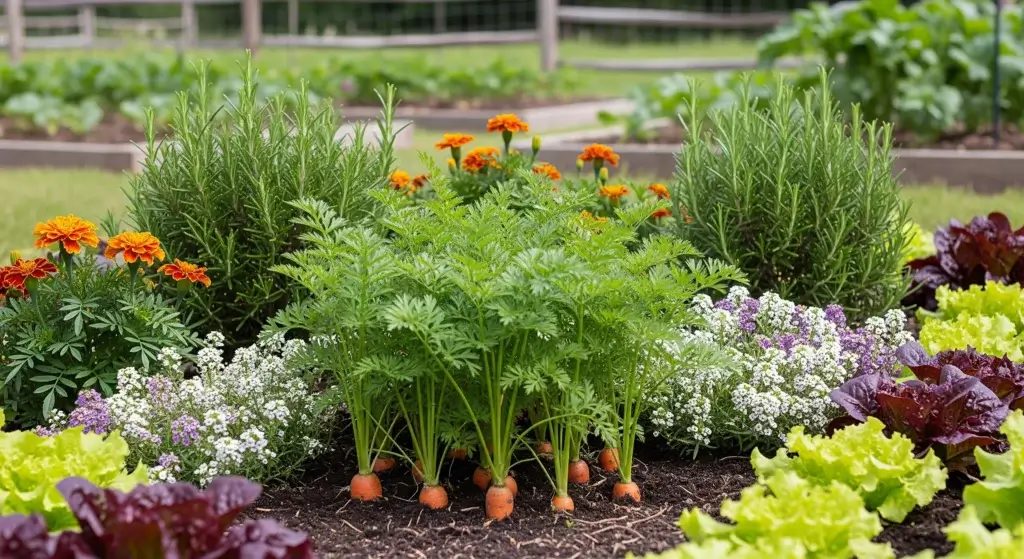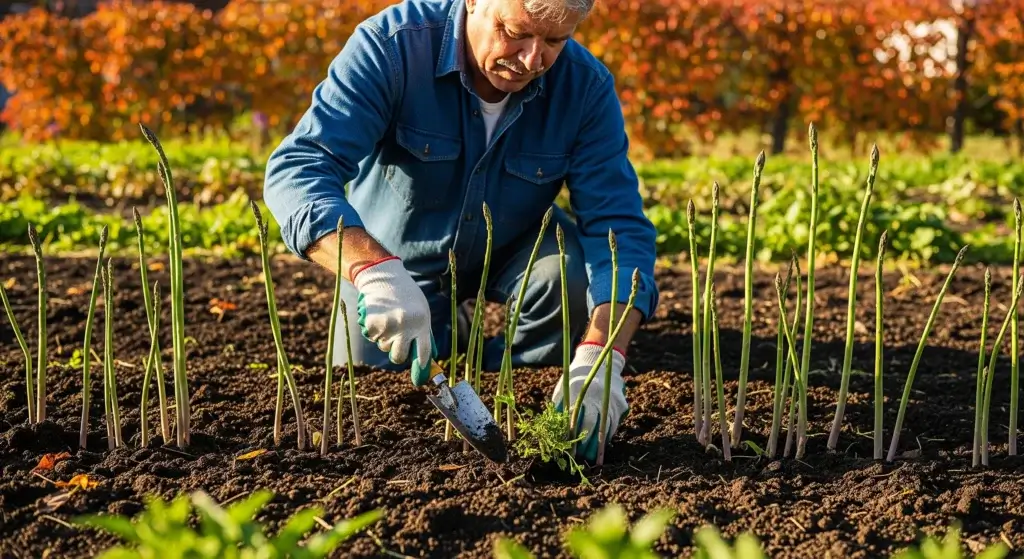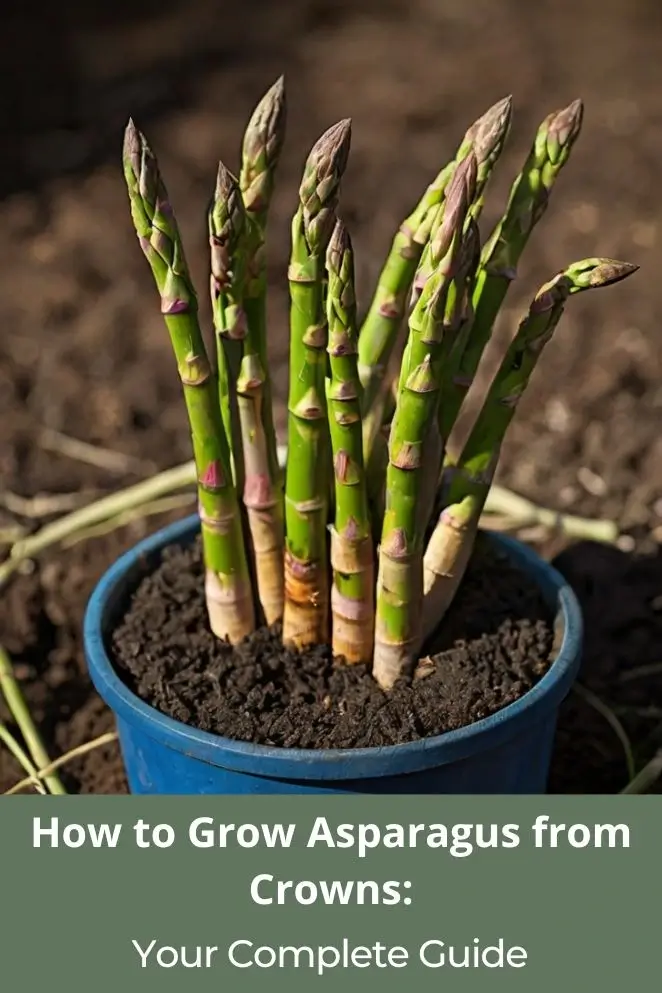
Want a veggie that keeps on giving? Grow asparagus from crowns.
Unlike annuals you replant every year, asparagus sticks around—15 to 20 years of tasty spears from one setup.
In this guide, you’ll learn how to plant, grow, and harvest asparagus the smart way.
Think of it as the Netflix series of your garden—long-running and always satisfying.
What Are Asparagus Crowns and Why Choose Them?
Asparagus crowns are just the roots of 1-year-old asparagus plants.
Imagine a sleeping plant with a root system ready to wake up and grow. That’s a crown.
It has a firm center (the crown itself) with thick roots around it.
These roots already store energy, so the plant can take off faster once it’s in the ground.
Why use crowns instead of seeds? Here’s the deal:
- Faster harvest: Crowns give you asparagus in year 2. Seeds? Add another year to that.
- Less drama: Crowns already have roots, so they handle transplant shock and weather better than baby seedlings.
- No surprises: You know exactly which variety you’re planting. No weird mystery spears.
- Easier start: Less pest pressure and less babysitting in the early stages.
When buying crowns, look for 8–10 chunky roots attached to a firm center with tiny buds showing.
Skip any that are dry, moldy, or beat up—they won’t perform well.
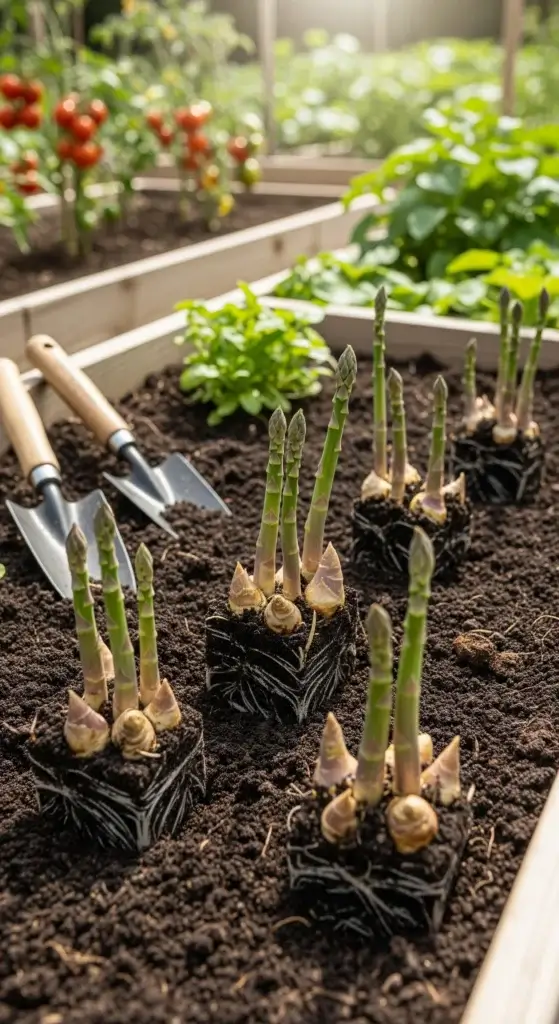
- Read also: Best Soil for Beetroot Gardening: Your Complete Guide
- Read also: How to Grow Mushrooms at Home: A Beginner’s Guide
Choosing the Perfect Location for Your Asparagus Bed
Asparagus sticks around for 15+ years, so where you plant it really matters.
You’re basically signing a long-term lease with these plants, so don’t rush the site choice.
Sunlight requirements
Give it at least 6–8 hours of direct sun every day. No shade. No half-sun.
Full sunlight means stronger spears and healthy fern growth—that’s how the plant recharges its energy like a phone on fast charge.
Soil conditions
Asparagus is picky about its roots. Here’s what it wants:
- Well-drained soil – If water pools in your garden after rain, don’t plant there. Asparagus roots rot fast in soggy soil.
- pH between 6.5–7.5 – That’s slightly alkaline. Acidic soil = sad asparagus.
- Lots of compost or aged manure – This plant is a heavy feeder. Mix in organic matter so it starts with a full fridge.
- High phosphorus – This helps build a big, healthy root system. Bone meal or rock phosphate works great here.
Space planning
Don’t crowd it. Plant each crown 12 inches apart in rows that are 5 feet apart.
A standard 4×8 ft raised bed can fit around 15–20 crowns—enough to keep a family of four eating asparagus without hitting the grocery store.
Soil Preparation: Setting the Foundation for Success
Asparagus doesn’t move. Once you plant it, it stays put for decades.
So yeah—prepping the soil properly isn’t optional.
Think of it like laying down the foundation for a house. Mess it up, and the whole thing wobbles.
Step 1: Test your soil’s pH
Grab a cheap soil test kit or digital pH meter from a garden store.
You’re aiming for pH 6.5 to 7.5.
- Too acidic (under 6.5)? Add agricultural lime.
- Too alkaline (over 7.5)? Add sulfur or a bunch of compost to bring it down slowly.
Do this a few weeks before planting—don’t rush it. Soil chemistry takes time to change.
Step 2: Dig deep (literally)
Asparagus roots go deep, so break up the soil 12–15 inches down.
Clear out every weed, root, and old sock hiding in there.
Mix in lots of compost or well-rotted manure in the top 10–12 inches.
The richer and looser the soil, the better those crowns will settle in and spread out.
Step 3: Fix bad drainage (or prepare for root rot)
If your soil holds water like a sponge, don’t ignore it. Fix it:
- Raised beds work great.
- Or mix in coarse sand and organic matter to help water drain faster.
Asparagus roots rot in soggy soil, and once they’re gone, the plant is toast.
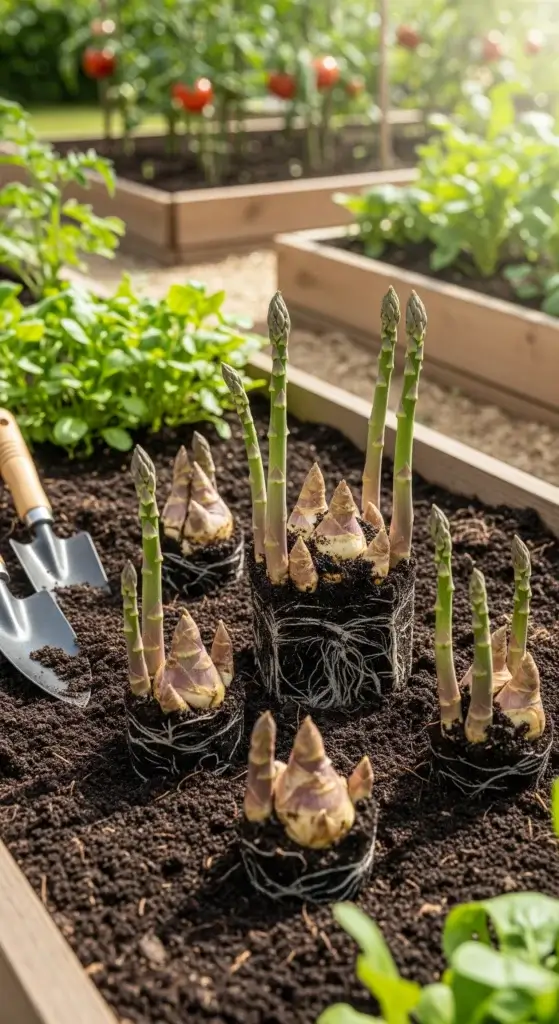
When to Plant Asparagus Crowns
Timing matters. Plant asparagus crowns in early spring, right when the soil’s soft enough to dig.
If you’re wondering when that is—it’s usually around the same time you’d plant potatoes.
Here’s a quick cheat sheet:
- North (cold winters): Late April to early May
- Mild zones: April or early May
- South (warmer winters): February to March
The goal? Get crowns in the ground 2–4 weeks before your last spring frost.
That way, they have time to settle in before summer heat kicks in—and you dodge frost damage to young spears.
Plant too late, and you’ll stress the crowns.
Plant too early, and frost might zap your new growth. Time it right, and you’re golden.
Step-by-Step Planting Guide
Planting asparagus isn’t rocket science, but there is a right way to do it.
Here’s how to get it done, step by step—so your crowns grow into a long-lasting asparagus patch instead of a garden fail.
Step 1: Dig the trenches
Start by digging a trench that’s 8 inches deep and 4–6 inches wide.
Think of it like a shallow moat for your asparagus army.
This gives the roots room to spread and makes it easy to backfill later.
Step 2: Make dirt mounds inside the trench
Every 12 inches, build a small 2-inch-high mound of soil right in the bottom of the trench.
This is where each crown will sit.
When planted, the crown should end up about 6 inches below the surface of your garden bed.
Step 3: Set the crowns right
Take each crown and place it on top of a mound like a little octopus.
Buds face up, roots spread out like bike spokes.
If you flip it upside down, the plant’s going to struggle—so don’t do that.
Step 4: Cover with a little soil
Gently cover the crowns with 2–3 inches of soil. Not all the way—just enough to tuck them in.
You’ll backfill the rest later.
Burying them too deep now makes it harder for young spears to push through.
Step 5: Fill in as they grow
As the spears grow taller, slowly add more soil to the trench.
Do this little by little over the first season until the trench is level with the rest of your garden bed.
Be patient—it takes all season.

Post-Planting Care and Maintenance
Planting asparagus is just the beginning.
If you want fat, tasty spears year after year, you’ve got to take care of those crowns—especially in year one.
Watering requirements
New crowns need water to settle in. Aim for 1–2 inches per week, whether from rain or your hose.
Once the plants are older, they can handle a little dryness—but they grow best when the soil stays moist (not soggy).
Fertilization program
Asparagus is a heavy feeder. Use a balanced fertilizer (10-10-10) twice a year:
- First dose: Early spring, just before the spears pop up
- Second dose: Right after harvest ends (this helps the ferns grow strong)
You can use a natural fertilizer if you prefer—just follow the same timing.
Weed management
Weeds are asparagus’s worst enemy—especially early on. They steal water, nutrients, and space.
- Lay down 3–4 inches of mulch (like straw or shredded leaves) to block weeds and hold moisture
- Hand-pull any weeds that break through—don’t hoe or dig, or you’ll damage the roots
Pest and disease management
Keep an eye out for asparagus beetles and their creepy little larvae.
In small numbers, you can just squish them by hand.
If they get out of control, hit them with an organic insecticide—follow the label.
Troubleshooting Common Problems
Even if you’ve done everything right, asparagus can still throw a tantrum.
Here’s how to deal with the most common issues before they wreck your harvest.
Problem: Thin, wimpy spears
Your spears look more like string beans than proper asparagus? That usually means:
- Too crowded – Crowns need space. If they’re packed too tight, they fight over nutrients. You might need to dig up and spread them out.
- Low on food – Asparagus is a heavy feeder. Give it balanced fertilizer in early spring and again after harvest.
- Over-harvesting – Don’t get greedy. In the early years, only harvest for a couple of weeks. Give the plant time to recover.
Problem: Hardly any spears
If you barely see any spears, the plant probably didn’t store enough energy last season.
- Sunlight matters – Make sure your bed gets at least 6–8 hours of full sun every day.
- Water + fertilizer after harvest – Let the ferns grow strong after you’re done picking. That’s how the plant recharges.
- Don’t cut ferns too early – Let them yellow and die back naturally in fall before removing them.
Problem: Crown rot
Crowns turning to mush? That’s rot. And it’s usually from too much water.
- Fix drainage – Raised beds work great if your garden soil stays wet.
- Don’t plant in soggy spots – Asparagus hates standing water. It’s not a swamp plant.
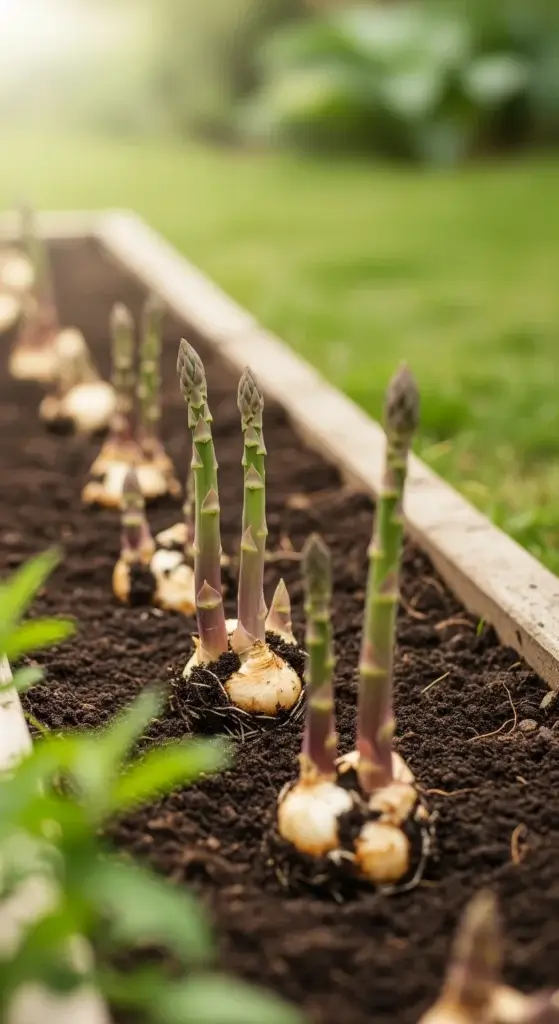
- Read also: A Step-by-Step Guide: How to Regrow Celery From Scraps
- Read also: Growing Peppers in Containers: Tips for Small Spaces
Final Take: Asparagus Is a Long Game, But Totally Worth It
Planting asparagus crowns takes time, but the payoff is huge—fresh spears every spring for 15+ years. You just need to:
- Pick the right sunny spot
- Prep the soil well
- Plant crowns the right way
- Stay patient and take care of them
The first couple of years are all about setup. After that, it’s harvest season every year like clockwork.
So yeah—it’s a marathon, not a sprint. But if you play it right, your future self will be eating like royalty.


